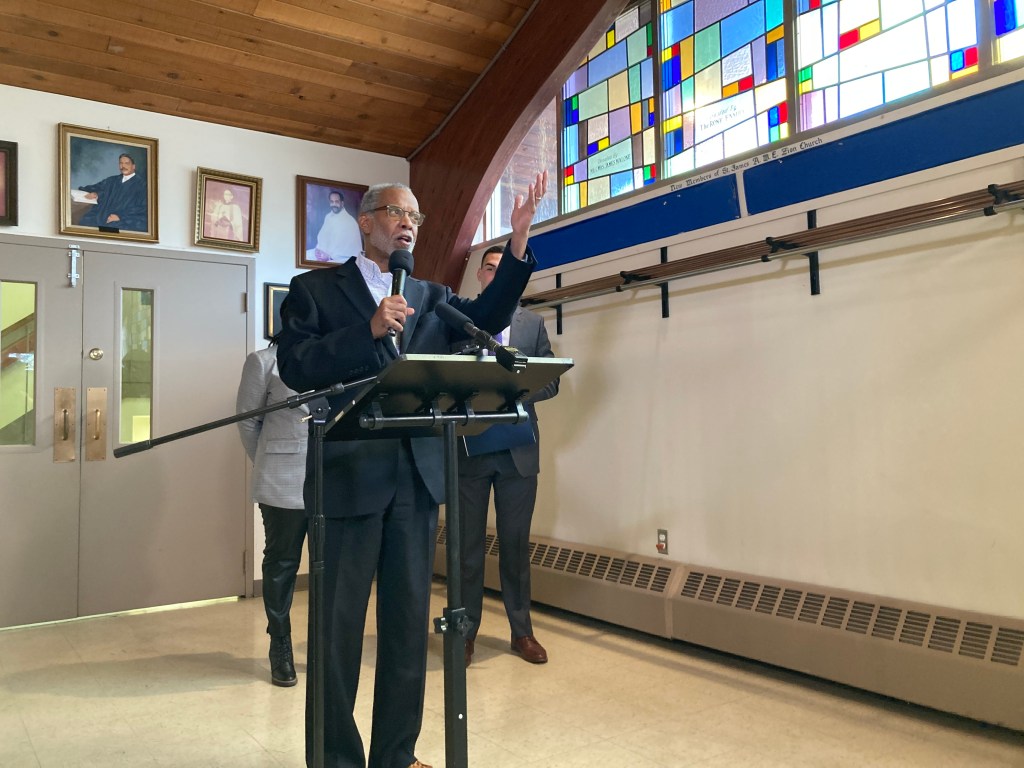Even as life for Black Pennsylvanians has shown marked improvements over the last decade — with significantly more having health insurance, graduating college and avoiding incarceration — challenges remain, according to the first State of Black Pennsylvania report.
State Sen. Art Haywood, the architect of the report, is traveling the state to discuss its findings. After recent visits to Harrisburg and Reading, he spoke Wednesday in the Lehigh Valley.
He was joined by fellow Democratic state Sen. Nick Miller of Lehigh County at St. James African Methodist Episcopal Zion Church in Allentown, along with some local Black leaders and community members.
“This is all very powerful and optimistic data that points to the power of hard work, advocacy and organizing,” Haywood said. “But I want to acknowledge that there’s so much work to do.”
The report, released Feb. 28, is based on the National Urban League’s state of Black America Report and focuses on how demographics, socioeconomic realities, education, health, incarceration and hate crimes have changed for Black Pennsylvanians from 2010 to 2021.
“Our people have overcome tremendous adversity over the years,” Haywood said. “We will continue to do so but we’ve got to look at what is working for us as we look at moving forward in this decade.”
The report uses data from the U.S. Census Bureau, the Pennsylvania Department of Corrections, the Pennsylvania Uniform Crime Reporting Program, the Kaiser Family Foundation and the Southern Poverty Law Center. It does not compare Pennsylvania’s Black population to other racial groups.
“What the Urban League does is compare Black to white year after year after year,” Haywood said. “The Black and white comparison does not take into account 200 years of enslavement, 100 years of segregation and continued discrimination, does not take into account the deep adversity which our people have faced.”
During the last decade, the median income of Black households increased by over $11,000 to $42,000. This 35% increase was faster than the 20% increase in real median income for the state as a whole. However, the median income for Black households in 2021 still lagged significantly behind the $72,600 median income for all households in the state, according to Federal Reserve Economic Data.
The number of Black households earning $100,000 or more climbed from 38,626 to 92,576 from 2010 to 2021. The percentage of Black people under the age of 65 in poverty also decreased, though the percentage 65 and older in poverty increased by 2 percentage points to 19%.
The number of Black students enrolled in school declined across the state, dropping from 436,990 students in 2010 to 353,490 in 2021. Andrene Brown Nowell, a member of the Allentown School Board, noted also that Black families are moving out of Pennsylvania and a national shortage of teachers. She said now is the time to create environments that are more welcoming and appealing to Black families.
“There are gaps in our education resources that are provided to Black students,” Nowell said. “Here in Allentown, 13.3% of Allentown School District students are Black, which also means that the likelihood that they will be taught by teachers that look like them are very slim. Representation is important across the board.”
Despite this, a greater share of Black Pennsylvanians attained some level of college education in 2021 than in 2011.
“This report points to the incredible strength and resilience of the Black community, particularly higher education enrollment, which is up 50% for Black women and up 75% for Black men,” Miller said.
Health was another area where Black Pennsylvanians made significant gains in the last decade.
The percentages of Black Pennsylvanians who had either private or public insurance increased by about 7 percentage points. And the percentage of Black people who had no health insurance as well as the percentage who didn’t have a personal doctor were each halved. A significantly smaller percentage of Black Pennsylvanians also reported smoking in 2021 than in 2010.
However, one disquieting health trend was the percentage of Black people who reported diabetes diagnoses increased from 13% to 16%.
During the past decade, the number of Black incarcerated individuals in state prisons fell by 32%, which Haywood said was the most surprising statistic for him.
The report attributed this in part to Pennsylvania reducing its overall rate of incarceration from 2010 through 2021. The proportion of the state prison population that is Black fell slightly as well, from roughly 49% of the total inmate population in 2010 to approximately 46% in 2021.
“Pennsylvania for several decades had incarceration going up, up, up, up and it is in this decade that it began to go down, a dramatic change largely due to the Wolf administration and those who focus on diversion as opposed to incarceration,” Haywood said.
The number of reported hate crimes in the state increased, and while the actual number of hate crimes increased a staggering 323%, Black people made up a slightly smaller percentage of hate crime victims 43% in 2021 versus 45% in 2011.
“We know we had a president that contributed to that and there is much work to be done,” Haywood said. “I got a report yesterday that white supremacy propaganda is flooding Pennsylvania. This is a serious challenge for us and there are clearly other challenges for us.”
Morning Call reporter Leif Greiss can be reached at 610-679-4028 or lgreiss@mcall.com.



